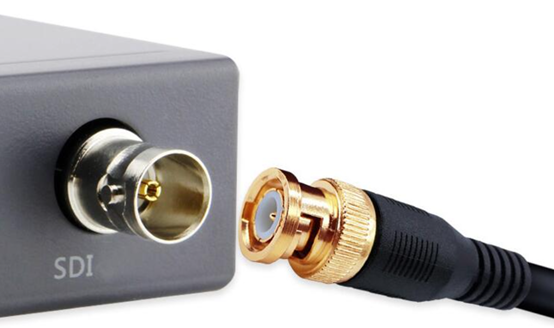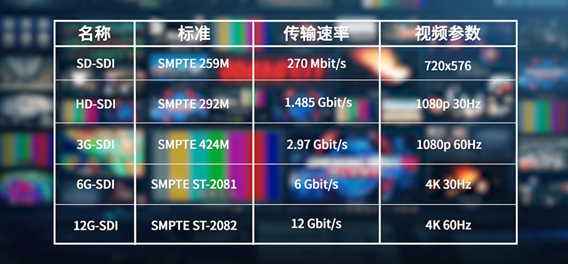Introduction
In the field of video transmission, SDI (Serial Digital Interface) signals are a widely used digital video transmission standard. Known for their high speed, high fidelity, and low latency, they play a crucial role in various domains such as broadcasting, film production, and video surveillance. This article will provide a detailed introduction to what SDI signals are, their classification, key characteristics and advantages, as well as common application cases.

What is an SDI Signal?
The Serial Digital Interface (SDI) is an interface standard used for transmitting high-quality, uncompressed digital video signals (which can also embed audio). It was developed by the Society of Motion Picture and Television Engineers (SMPTE) and is typically presented using BNC connectors. Signals transmitted according to this interface standard are referred to as SDI signals. In short, SDI is a transmission protocol, and a standard signal transmitted via this protocol is an SDI signal. SDI signals transmit data serially in a digital format, ensuring high-speed, stable, and reliable transmission of video signals.
Classification of SDI Signals
SDI signals can be classified into various types based on the different supported interface transmission rates. Different SDI interface types correspond to different defined standards and video parameters. The common types of SDI signals are shown in the figure below.

SD-SDI:A trusted SDI variant, its full name is Standard Definition Serial Digital Interface, corresponding to the SMPTE 259M standard. SD-SDI supports various bitrates: 270, 360, 143, and 177 Mbit/s. This diversity allows it to handle different video quality levels. In terms of video format examples, SD-SDI supports 480i and 576i. These are standard definition formats, making them suitable for basic broadcast applications.
HD-SDI:Stands for High Definition Serial Digital Interface. Its standard is SMPTE 292M, introduced in 1998. HD-SDI supports two bitrates: 1485 Mbit/s and 1485/1.001 Mbit/s, significantly higher than its predecessor. Such high bitrates ensure transmission quality, maintaining fidelity when sending video signals over coaxial cable. It supports formats like 720p and 1080i, which are high-resolution, thereby increasing video data clarity. HD-SDI revolutionized the industry, making the concept of high-definition serial digital interface a reality. HD-SDI is also commonly used in the security surveillance field for high-definition cameras.
3G-SDI:Represents the third-generation Serial Digital Interface. The standard is SMPTE 424M, supporting higher bitrates and frame rates. Notably, its bitrate can manage 2970 Mbit/s and 2970/1.001 Mbit/s, indicating very high data transfer rates. Supported video formats include 1080p60, providing high-definition video and a smooth viewing experience.
6G-SDI:The sixth-generation Serial Digital Interface, specified by SMPTE ST 2081, supports Ultra High Definition (UHD) video transmission. 6G-SDI supports advanced video formats, for example, 1080p120 and 2160p30. These formats provide UHD video, translating into a stronger viewing experience.
12G-SDI:An innovation in SDI technology. It stands for the twelfth-generation Serial Digital Interface. Its specified standard is SMPTE ST 2082. This format emerged in 2015, offering higher performance than previous versions. A key feature of 12G-SDI is its bitrate, supporting rates up to 11970 Mbit/s, a huge leap in data transfer speed. It supports UHD video transmission at higher data rates, such as formats like 2160p60.
Characteristics and Advantages of SDI Signals
High-Quality Transmission: SDI signals transmit uncompressed digital video, preserving the original video quality and ensuring image clarity and fidelity.
High Bandwidth & High Speed: SDI signals support high-bandwidth and high-speed data transmission, meeting the demands of HD and UHD video transmission.
Low Latency: Due to the direct transmission method, SDI signals have extremely low transmission latency, making them ideal for real-time monitoring and applications requiring immediate response.
Strong Noise Immunity: Compared to analog signals, SDI digital signals have much stronger noise immunity, maintaining stable signal quality over longer distances.
Strong Compatibility: The standardized SDI interface is compatible with various professional devices, enabling seamless interconnection between equipment from different brands and models.
Common Application Cases
Broadcast Television: SDI signals are widely used in program production, transmission, and broadcasting within television stations. They ensure the HD picture quality and real-time nature of TV programs, enhancing the viewer experience.
Film Production: In film production, SDI signals have become the standard interface for cameras, recorders, and other equipment. The SDI interface allows easy connection of various devices for high-quality video capture and transmission.
Video Surveillance: In the security surveillance field, SDI cameras are widely used in places requiring high-definition monitoring, such as banks, airports, and shopping malls, due to their lossless video transmission capability. SDI signals provide clear video footage, helping surveillance personnel accurately assess situations.
Post-Production: In film and video post-production, SDI signals are used to connect devices like non-linear editing systems and color grading systems. The SDI interface enables high-quality video material transfer and processing, improving post-production efficiency and quality.
Professional Video Production: For scenarios requiring high-quality video output, such as corporate promotional videos and advertising shoots, SDI signals are also an indispensable part. They ensure every stage of video production maintains high quality and stability.